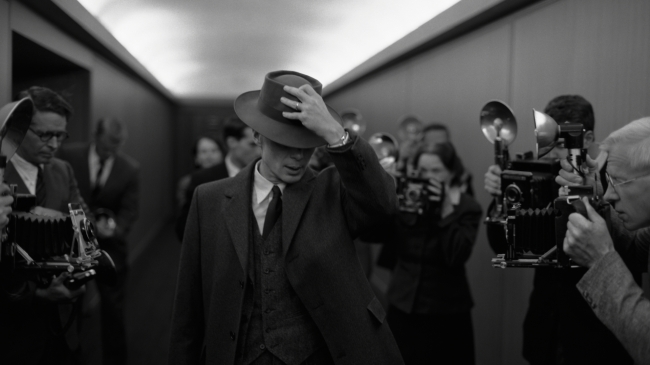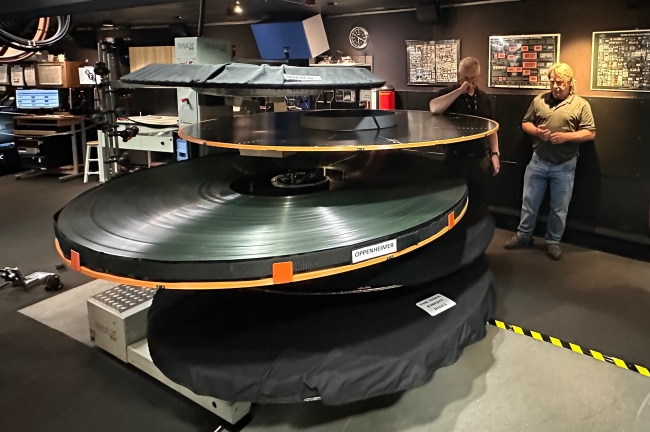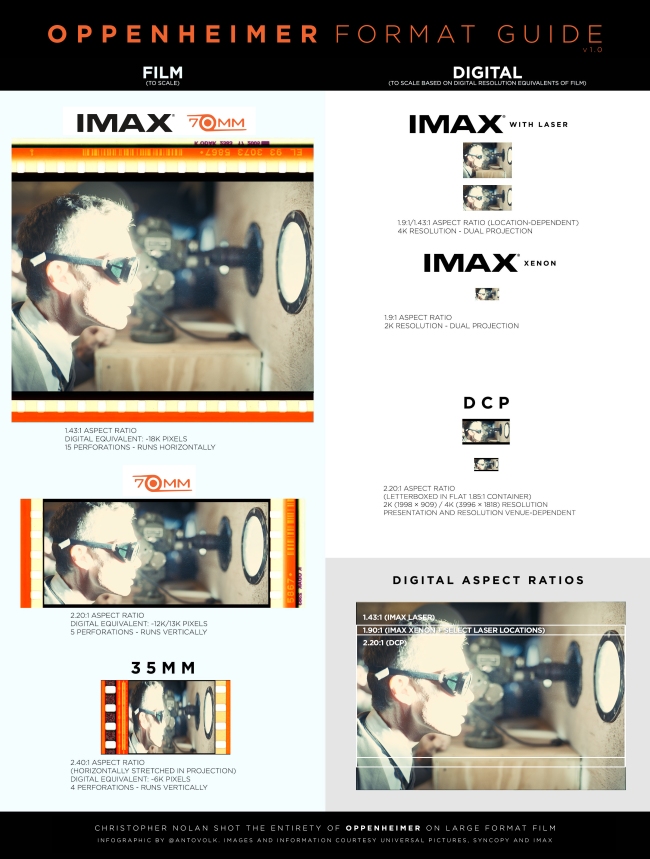Christopher Nolan has been an analog guru and a large-format IMAX advocate since at least “The Dark Knight.” After shooting substantial portions of “Interstellar,” “Dunkirk, and “Tenet” in 15-perf 70mm IMAX, he now brings to theaters the epic “Oppenheimer” in the format, which offers 10 times the resolution of standard projection formats.
“IMAX film is the highest resolution film that’s ever been used, but it had never been used in Hollywood films until ‘Dark Knight,’” said Nolan. “I’d seen IMAX films in museums and was fascinated about it as a kid and used the fact that I was doing a [Batman] sequel to negotiate with the studio about using it as a camera.”
With “Interstellar,” which began Nolan’s integral collaboration with cinematographer Hoyte van Hoytema, the director grew increasingly experimental with the IMAX camera, culminating with his most daring use yet on “Oppenheimer,” the biopic thriller about physicist J. Robert Oppenheimer (Cillian Murphy), the “father of the atomic bomb.” Nolan and van Hoytema used the IMAX camera to explore the dual landscapes of Los Alamos (where the first atomic bomb was tested) and Oppenheimer’s face for a more intimate cinematic spectacle.
“What large-format photography gives you is clarity, first and foremost,” said Nolan in the “Oppenheimer” production notes. “It’s a format that allows the audience to become fully immersed in the story and in the reality that you’re taking them to. In the case of ‘Oppenheimer,’ it’s a story of great scope and great scale and great span. But I also wanted the audience to be in the rooms where everything happened, as if you are there, having conversations with these scientists in these important moments.”
But not all movie theaters are created equal, and the 70mm IMAX format isn’t available everywhere. Here, IndieWire explains how “Oppenheimer” manages to be in multiple formats and what you lose (or gain) from watching it in one versus the others.

“Oppenheimer”Universal Pictures
“Oppenheimer,” like “Dunkirk” and “Tenet,” was shot with both IMAX and large-format Panavision cameras, primarily due to sound issues with the noisy IMAX camera. The “Oppenheimer” film crew carried two to four IMAX film cameras, depending on need, but did its best to use IMAX whenever possible. (Seventy percent of “Dunkirk” and 50 percent of “Tenet” were shot using IMAX cameras.) Panavision supplied Panavision System 65 Studio film cameras for the non-IMAX portions of the movie.
Kodak supplied 65mm film for both the IMAX and Panavision cameras: 250D (5207) and 500T (5219) color 65mm negative, and Double-X (5222) black-and-white negative. The large-format black-and-white was at the request of Nolan and van Hoytema and was a first for Kodak — it had never finished 65mm black-and-white film for IMAX — and required a partnership between Kodak/FotoKem/IMAX and Panavision to support the 65mm black-and-white workflow.
Put simply, shooting this way captures images at the highest resolution and clarity. Even if you’re striking 35mm prints or creating DCPs, the better the source image, the better the various iterations will be. “This is the exciting thing about shooting an IMAX film,” Nolan told The Associated Press. “When you scan it for the digital format, you’re working with the absolute best possible image that you could acquire, and that translates wonderfully to the new projector formats like the laser projectors.”
Starting with “The Dark Knight,” Nolan developed a system that they call “center punching the action” so that nothing is lost. Van Hoytema is also always aware of the “frame lines for the different theaters” when looking through the camera. On the biggest presentations, IMAX 1.43:1 (the massive square screen), the screen essentially disappears for the audience. For formats such as 35mm, the top and the bottom get cropped. But, Nolan said, “From a creative point of view, what we’ve found over the years is that there’s no compromise to composition.”

The 70mm IMAX print of “Oppenheimer”David Keighley/IMAX
According to IMAX, when presented in 70mm IMAX, the “Oppenheimer” sequences shot on 15-perf IMAX are printed full quality in their native format for the highest possible visual presentation, filling the giant IMAX screen from top to bottom (1.43:1 aspect ratio). The 5-perf 65mm sequences fill the IMAX screen side-to-side (2.20:1 aspect ratio). The finished picture is fully analog and switches between the 2.20:1 and 1.43:1 aspect ratios throughout. This is combined with an IMAX uncompressed 16 bit/44.1kHz 5.0 digital sound mix.
Digital IMAX: IMAX premiered digital projectors in 2008 and initial digital projectors had an innovative dual 2K design. Today’s projectors are laser 4K. The IMAX digital presentation has been created from 8k scans of the original film elements, graded specifically for the high contrast dual-projector IMAX digital projectors, before being scaled to 4K resolution and packaged with the uncompressed 24bit/48kHz IMAX 5.0 sound mix.

70mm: When presented on regular 70mm film, the sequences shot on 5-perf 65mm are presented in their native format, the IMAX sequences have been optically reduced to 70mm 5-perf film to produce a grain-free, ultra-high resolution image, cropped top and bottom to fill the wider frame. This process is photochemical, preserving the original analog color of the imagery and presented in a 2.2:1 aspect ratio. The sound is carried on a separate DTS disc to produce state-of-the-art 6-track digital sound.
35mm: The 35mm prints have been made photochemically, preserving all the rich analog color of the original 65mm photography, and cropped top and bottom to create a seamless 2.35:1 anamorphic image. The sound is coded on the prints in Dolby SR as well as Dolby 5.1 and DTS for 6-track digital playback.
Sound: While a handful of sound experts and purists might be able to discern slight differences between the various print formats and DCPs — one projectionist IndieWire spoke to argued that the regular 70mm prints might be slightly inferior because DTS audio is compressed and the other formats are not — for 99 percent of the audience, the distinctions between presentations in terms of audio will be negligible. No matter what format you see “Oppenheimer” in, it should sound terrific; according to Universal, the sound has been specifically mixed to maximize the power of the low-end frequencies in the main channels as well as in the subwoofer channel. This effect will be present in all available presentations of “Oppenheimer,” all of which have been designed to play back at the volume level designated by the industry at 7 on the Dolby cinema processor.
For Nolan, when it comes to viewing “Oppenheimer,” there’s one clear choice above all others. In an interview with the Associated Press, he said, “The sharpness and the clarity and the depth of the image is unparalleled. The headline, for me, is by shooting on IMAX 70mm film, you’re really letting the screen disappear. You’re getting a feeling of 3D without the glasses. You’ve got a huge screen and you’re filling the peripheral vision of the audience. You’re immersing them in the world of the film.”
With “Oppenheimer,” Nolan has made his biggest push yet for 70mm IMAX exhibition — his format of choice with the highest resolution. According to IMAX, 30 theaters out of a possible 50 worldwide will screen “Oppenheimer” in 70mm IMAX (including 19 in the U.S. and six in Canada). In addition, more than 100 will screen the movie in 70mm and nearly 100 in 35mm.
As IndieWire’s Jim Hemphill reported, the TCL IMAX Chinese Theater in Hollywood required a larger projection booth to fit the enormous size of the “Oppenheimer” 70mm IMAX film platter. All 53 reels were spliced together (spanning 11 miles) with orange extension edges to accommodate the 3-hour running time.
Here is a list of 70mm IMAX North American theaters listed on the IMAX site:
Arizona
Harkins Arizona Mills 25 & IMAX – Tempe, AZ
California
AMC Metreon 16 & IMAX – San Francisco, CA
Universal Cinema AMC at CityWalk Hollywood & IMAX – Universal City, CA
TCL Chinese Theater IMAX – Hollywood CA
Regal Edwards Ontario Palace & IMAX – Ontario, CA
Regal Irvine Spectrum 21 + IMAX – Irvine CA
Esquire IMAX – Sacramento, CA
Regal Hacienda Crossings & IMAX – Dublin, CA
Florida
AutoNation IMAX, Museum of Discovery & Science – Fort Lauderdale, FL
Georgia
Regal Mall of Georgia & IMAX – Buford, GA
Indiana
IMAX Theatre at Indiana State Museum – Indianapolis, IN
Michigan
Chrysler IMAX Dome Theatre, Michigan Science Center – Detroit, MI
Celebration! Cinema Grand Rapids North & IMAX – Grand Rapids, MI
New York
AMC Lincoln Square 13 & IMAX – New York, NY
Pennsylvania
Regal UA King of Prussia & IMAX – King of Prussia, PA
Rhode Island
Providence Place Cinemas 16 and IMAX – Providence, RI
Texas
AMC Rivercenter 11 & IMAX – San Antonio, TX
Cinemark 17 & IMAX – Dallas, TX
Tennessee
Regal Opry Mills & IMAX – Nashville, TN
Canada
Scotiabank Chinook & IMAX – Calgary, AB
Scotiabank Edmonton & IMAX – Edmonton, AB
Cineplex Cinemas Langley & IMAX – Langley, BC
Cineplex Cinemas Mississauga & IMAX – Mississauga, ON
Cineplex Cinemas Vaughan & IMAX – Woodbridge ,ON
Kramer IMAX, Saskatchewan Science Centre – Regina, SK
“IMAX film is the highest resolution film that’s ever been used, but it had never been used in Hollywood films until ‘Dark Knight,’” said Nolan. “I’d seen IMAX films in museums and was fascinated about it as a kid and used the fact that I was doing a [Batman] sequel to negotiate with the studio about using it as a camera.”
With “Interstellar,” which began Nolan’s integral collaboration with cinematographer Hoyte van Hoytema, the director grew increasingly experimental with the IMAX camera, culminating with his most daring use yet on “Oppenheimer,” the biopic thriller about physicist J. Robert Oppenheimer (Cillian Murphy), the “father of the atomic bomb.” Nolan and van Hoytema used the IMAX camera to explore the dual landscapes of Los Alamos (where the first atomic bomb was tested) and Oppenheimer’s face for a more intimate cinematic spectacle.
“What large-format photography gives you is clarity, first and foremost,” said Nolan in the “Oppenheimer” production notes. “It’s a format that allows the audience to become fully immersed in the story and in the reality that you’re taking them to. In the case of ‘Oppenheimer,’ it’s a story of great scope and great scale and great span. But I also wanted the audience to be in the rooms where everything happened, as if you are there, having conversations with these scientists in these important moments.”
But not all movie theaters are created equal, and the 70mm IMAX format isn’t available everywhere. Here, IndieWire explains how “Oppenheimer” manages to be in multiple formats and what you lose (or gain) from watching it in one versus the others.

“Oppenheimer”Universal Pictures
How ‘Oppenheimer’ was shot
“Oppenheimer,” like “Dunkirk” and “Tenet,” was shot with both IMAX and large-format Panavision cameras, primarily due to sound issues with the noisy IMAX camera. The “Oppenheimer” film crew carried two to four IMAX film cameras, depending on need, but did its best to use IMAX whenever possible. (Seventy percent of “Dunkirk” and 50 percent of “Tenet” were shot using IMAX cameras.) Panavision supplied Panavision System 65 Studio film cameras for the non-IMAX portions of the movie.
Kodak supplied 65mm film for both the IMAX and Panavision cameras: 250D (5207) and 500T (5219) color 65mm negative, and Double-X (5222) black-and-white negative. The large-format black-and-white was at the request of Nolan and van Hoytema and was a first for Kodak — it had never finished 65mm black-and-white film for IMAX — and required a partnership between Kodak/FotoKem/IMAX and Panavision to support the 65mm black-and-white workflow.
Put simply, shooting this way captures images at the highest resolution and clarity. Even if you’re striking 35mm prints or creating DCPs, the better the source image, the better the various iterations will be. “This is the exciting thing about shooting an IMAX film,” Nolan told The Associated Press. “When you scan it for the digital format, you’re working with the absolute best possible image that you could acquire, and that translates wonderfully to the new projector formats like the laser projectors.”
Starting with “The Dark Knight,” Nolan developed a system that they call “center punching the action” so that nothing is lost. Van Hoytema is also always aware of the “frame lines for the different theaters” when looking through the camera. On the biggest presentations, IMAX 1.43:1 (the massive square screen), the screen essentially disappears for the audience. For formats such as 35mm, the top and the bottom get cropped. But, Nolan said, “From a creative point of view, what we’ve found over the years is that there’s no compromise to composition.”

The 70mm IMAX print of “Oppenheimer”David Keighley/IMAX
What You Lose or Gain in Different Formats and Technical Specs
According to IMAX, when presented in 70mm IMAX, the “Oppenheimer” sequences shot on 15-perf IMAX are printed full quality in their native format for the highest possible visual presentation, filling the giant IMAX screen from top to bottom (1.43:1 aspect ratio). The 5-perf 65mm sequences fill the IMAX screen side-to-side (2.20:1 aspect ratio). The finished picture is fully analog and switches between the 2.20:1 and 1.43:1 aspect ratios throughout. This is combined with an IMAX uncompressed 16 bit/44.1kHz 5.0 digital sound mix.
Digital IMAX: IMAX premiered digital projectors in 2008 and initial digital projectors had an innovative dual 2K design. Today’s projectors are laser 4K. The IMAX digital presentation has been created from 8k scans of the original film elements, graded specifically for the high contrast dual-projector IMAX digital projectors, before being scaled to 4K resolution and packaged with the uncompressed 24bit/48kHz IMAX 5.0 sound mix.

70mm: When presented on regular 70mm film, the sequences shot on 5-perf 65mm are presented in their native format, the IMAX sequences have been optically reduced to 70mm 5-perf film to produce a grain-free, ultra-high resolution image, cropped top and bottom to fill the wider frame. This process is photochemical, preserving the original analog color of the imagery and presented in a 2.2:1 aspect ratio. The sound is carried on a separate DTS disc to produce state-of-the-art 6-track digital sound.
35mm: The 35mm prints have been made photochemically, preserving all the rich analog color of the original 65mm photography, and cropped top and bottom to create a seamless 2.35:1 anamorphic image. The sound is coded on the prints in Dolby SR as well as Dolby 5.1 and DTS for 6-track digital playback.
Sound: While a handful of sound experts and purists might be able to discern slight differences between the various print formats and DCPs — one projectionist IndieWire spoke to argued that the regular 70mm prints might be slightly inferior because DTS audio is compressed and the other formats are not — for 99 percent of the audience, the distinctions between presentations in terms of audio will be negligible. No matter what format you see “Oppenheimer” in, it should sound terrific; according to Universal, the sound has been specifically mixed to maximize the power of the low-end frequencies in the main channels as well as in the subwoofer channel. This effect will be present in all available presentations of “Oppenheimer,” all of which have been designed to play back at the volume level designated by the industry at 7 on the Dolby cinema processor.
For Nolan, when it comes to viewing “Oppenheimer,” there’s one clear choice above all others. In an interview with the Associated Press, he said, “The sharpness and the clarity and the depth of the image is unparalleled. The headline, for me, is by shooting on IMAX 70mm film, you’re really letting the screen disappear. You’re getting a feeling of 3D without the glasses. You’ve got a huge screen and you’re filling the peripheral vision of the audience. You’re immersing them in the world of the film.”
Where to see ‘Oppenheimer’ in 70mm IMAX
With “Oppenheimer,” Nolan has made his biggest push yet for 70mm IMAX exhibition — his format of choice with the highest resolution. According to IMAX, 30 theaters out of a possible 50 worldwide will screen “Oppenheimer” in 70mm IMAX (including 19 in the U.S. and six in Canada). In addition, more than 100 will screen the movie in 70mm and nearly 100 in 35mm.
As IndieWire’s Jim Hemphill reported, the TCL IMAX Chinese Theater in Hollywood required a larger projection booth to fit the enormous size of the “Oppenheimer” 70mm IMAX film platter. All 53 reels were spliced together (spanning 11 miles) with orange extension edges to accommodate the 3-hour running time.
Here is a list of 70mm IMAX North American theaters listed on the IMAX site:
Arizona
Harkins Arizona Mills 25 & IMAX – Tempe, AZ
California
AMC Metreon 16 & IMAX – San Francisco, CA
Universal Cinema AMC at CityWalk Hollywood & IMAX – Universal City, CA
TCL Chinese Theater IMAX – Hollywood CA
Regal Edwards Ontario Palace & IMAX – Ontario, CA
Regal Irvine Spectrum 21 + IMAX – Irvine CA
Esquire IMAX – Sacramento, CA
Regal Hacienda Crossings & IMAX – Dublin, CA
Florida
AutoNation IMAX, Museum of Discovery & Science – Fort Lauderdale, FL
Georgia
Regal Mall of Georgia & IMAX – Buford, GA
Indiana
IMAX Theatre at Indiana State Museum – Indianapolis, IN
Michigan
Chrysler IMAX Dome Theatre, Michigan Science Center – Detroit, MI
Celebration! Cinema Grand Rapids North & IMAX – Grand Rapids, MI
New York
AMC Lincoln Square 13 & IMAX – New York, NY
Pennsylvania
Regal UA King of Prussia & IMAX – King of Prussia, PA
Rhode Island
Providence Place Cinemas 16 and IMAX – Providence, RI
Texas
AMC Rivercenter 11 & IMAX – San Antonio, TX
Cinemark 17 & IMAX – Dallas, TX
Tennessee
Regal Opry Mills & IMAX – Nashville, TN
Canada
Scotiabank Chinook & IMAX – Calgary, AB
Scotiabank Edmonton & IMAX – Edmonton, AB
Cineplex Cinemas Langley & IMAX – Langley, BC
Cineplex Cinemas Mississauga & IMAX – Mississauga, ON
Cineplex Cinemas Vaughan & IMAX – Woodbridge ,ON
Kramer IMAX, Saskatchewan Science Centre – Regina, SK

